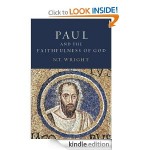Where Tom agrees with Sanders is that the Christ event made him take a more radical view of the plight than he had when he was a Pharisee. And this in turn affected his view of the Law— if righteousness came through obedience to the Mosaic Law, then Christ died for nothing. That was a conclusion Paul could not accept (p. 750). Further, the resurrection of Jesus made clear that the plight involved creation itself, all of creation would need redemption, even its physical character. Finally the coming of the Spirit made clear that all had sinned, all were hard hearted, and all needed the internal work of the Spirit to do away with that condition, even devout Jews. So cross, resurrection, Spirit causes a radicalized view of the human plight, indeed the plight of all creation. “Paul was like a man on the way to collect a prescribed medication studies the doctor’s note and concludes from the recommended remedy that his illness must be far more serious than he realized.” (p. 751).
Yet there was paradox involved because the Jesus of recent memory, while he was raised and exalted to God’s right hand, had not fulfilled various expectations normally associated with the Messiah—Jesus “had not delivered Israel from the pagans, hand not intensified Israel’s own law observance, hand not cleansed and rebuilt the Temple, and had not brought justice and peace to the world after the manner of Isaiah’s dream.” (p. 751). No, he had not, which is precisely why more emphasis than we get in Tom’s exposition needs to be placed on what Paul says about the not yet, rather than the already of Christ’s work. But perhaps that will come in the second half of this monumental study. For now however its enough to say that it is hard sell to identify the YOM YAHWEH with Jesus’ first coming.
On p. 752 Tom begins to explain in detail why those three factors indicated to Paul that the plight must be much more severe than previously thought. The first of these is a crucified Messiah. If Messiah was crucified, then Jews themselves must be enmeshed in human sin just as gentiles are. Wright suggests that the cross functioned for Paul as the same kind of wake up call as the fall of the Temple did for the author of 4 Ezra, and it led them both to trace the problem back to Adam. “For 4 Ezra and 2 Baruch the Temple had fallen but the Messiah had not yet come; for Paul the Messiah had come, been crucified and raised but the Temple was still standing. The parallels are as important as the differences. In both cases the events which had happened pointed to a radicalization of the plight.” (p. 762).
Tom stresses that through Paul’s Damascus Road experience, he came to realize that the real problem was sin and death (and thus not primarily pagan rulers, as Jews might have previously assumed). Israel could not fulfill its mission which God had intended for humankind, and indeed for his chosen people, due to sin and death infecting and affecting Israel. Thus, what comes to pass in the death and res. of Jesus is the setting up of a new, justified,transformed people of God, a new family of Abraham (p. 761). Thus the climax at the end of Rom. 8 tells us that the victory is not merely over rulers, or even angelic powers, but also over sin and death.
The only thing which would solve the problem is for both Jew and Gentile to put to death their old fallen identity. Under these conditions, as Tom says on p. 754 the Law simply exacerbates the problem, and thus becomes a problem itself. Rather than being a mere correction of sin, it becomes a stimulus to sin giving people lots of good ideas as to how to commit sins and what counts as sins. Humans are made for glory, and glory doesn’t primarily mean dying and going to some individualized heaven, it means humans are destined to be raised from the dead, conformed to the image of Jesus inheriting the whole of creation as our sphere of continuing existence and responsibility (see Rom. 8).
One of the more interesting aspects of Tom’s treatment of the plight, as now seen in light of the resurrection is that sin and death, have become Sin and Death, by which is meant Sin and Death are suprahuman powers in Paul’s world view (with a nod in the direction of the work of Walter Wink). It is not however exactly clear what Tom means by this (p. 756). What he is suggesting certainly is that sin and death are endemic to all of creation, and so its not just a personal human problem. And the problem involves disease, decay, and death, suffering sin and sorrow, not just personal sin and human death. Interestingly, Paul quotes Is. 25.6-10 as promising life beyond death on earth, which is something not even Is.65.17ff. envisioned.
The third factor which led to a revision of understanding of the plight was the coming of the Spirit. Here Paul rightly puts more stress on the renewal of the human heart. Wright says that Paul puts more stress on this result of the Spirit’s work than one sees elsewhere in early Judaism, not a surprise since other early Jews didn’t believe Joel 2 had already been fulfilled.













